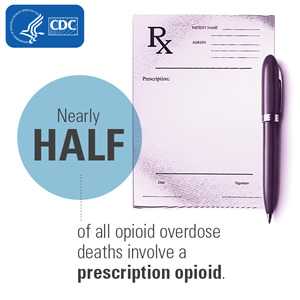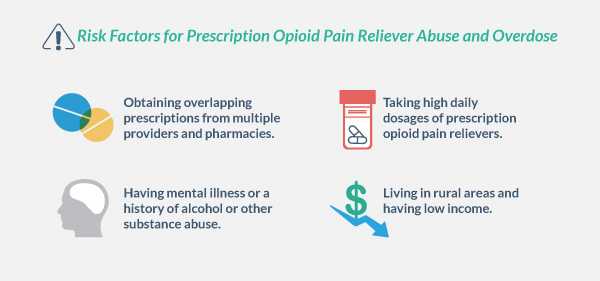Prescription Opioids
Prescription opioids can be used to treat moderate-to-severe pain and are often prescribed following surgery or injury, or for health conditions such as cancer. In recent years, there has been a dramatic increase in the acceptance and use of prescription opioids for the treatment of chronic, non-cancer pain, such as back pain or osteoarthritis, despite serious risks and the lack of evidence about their long-term effectiveness.
Side Effects

In addition to the serious risks of addiction, abuse, and overdose, the use of prescription opioids can have a number of side effects, even when taken as directed:
- Tolerance—meaning you might need to take more of the medication for the same pain relief
- Physical dependence—meaning you have symptoms of withdrawal when the medication is stopped
- Increased sensitivity to pain
- Constipation
- Nausea, vomiting, and dry mouth
- Sleepiness and dizziness
- Confusion
- Depression
- Low levels of testosterone that can result in lower sex drive, energy, and strength
- Itching and sweating
When the Prescription Becomes the Problem
- Providers wrote nearly a quarter of a billion opioid prescriptions in 2013—with wide variation across states. This is enough for every American adult to have their own bottle of pills.1
- Health care providers in the highest prescribing state, Alabama, wrote almost three times as many of these prescriptions per person as those in the lowest prescribing state, Hawaii.2
- Studies suggest that regional variation in use of prescription opioids cannot be explained by the underlying health status of the population.2
- The most common drugs involved in prescription opioid overdose deaths include:
- Methadone
- Oxycodone (such as OxyContin®)
- Hydrocodone (such as Vicodin®)3
To reverse this epidemic, we need to improve the way we treat pain. We must prevent abuse, addiction, and overdose before they start.
Risk Factors for Prescription Opioid Abuse and Overdose
 Research shows that some risk factors make people particularly vulnerable to prescription opioid abuse and overdose, including:
Research shows that some risk factors make people particularly vulnerable to prescription opioid abuse and overdose, including:
- Obtaining overlapping prescriptions from multiple providers and pharmacies.7,8,9,10
- Taking high daily dosages of prescription pain relievers.8,11,12,13
- Having mental illness or a history of alcohol or other substance abuse.14
- Living in rural areas and having low income.15
Medicaid Patients
- Inappropriate prescribing practices and opioid prescribing rates are substantially higher among Medicaid patients than among privately insured patients.
- In one study based on 2010 data, 40% of Medicaid enrollees with prescriptions for pain relievers had at least one indicator of potentially inappropriate use or prescribing:9
- overlapping prescriptions for pain relievers,
- overlapping pain reliever and benzodiazepine prescriptions,
- long-acting or extended release prescription pain relievers for acute pain, and
- high daily doses.
Addiction and Overdose
Anyone who takes prescription opioids can become addicted to them. In fact, as many as one in four patients receiving long-term opioid therapy in a primary care setting struggles with opioid addiction.4,5,6 Once addicted, it can be hard to stop. In 2014, nearly two million Americans either abused or were dependent on prescription opioid pain relievers.
Taking too many prescription opioids can stop a person’s breathing—leading to death.
Prescription opioid overdose deaths also often involve benzodiazepines. Benzodiazepines are central nervous system depressants used to sedate, induce sleep, prevent seizures, and relieve anxiety. Examples include alprazolam (Xanax®), diazepam (Valium®), and lorazepam (Ativan®). Avoid taking benzodiazepines while taking prescription opioids whenever possible.
References
- IMS Health, National Prescription Audit (NPATM). Cited in internal document: Preliminary Update on Opioid Pain Reliever (OPR) Prescription Rates Nationally and by State: 2010-2013.
- Centers for Disease Control and Prevention. Vital Signs: Variation Among States in Prescribing of Opioid Pain Relievers and Benzodiazepines — United States, 2012. MMWR 2014; 63(26);563-568.
- Ossiander EM. Using textual cause-of-death data to study drug poisoning deaths. Am J Epidemiol 2014 Apr 1;179(7):884-94.
- Banta-Green CJ, Merrill JO, Doyle SR, Boudreau DM, Calsyn DA. Opioid use behaviors, mental health and pain—development of a typology of chronic pain patients. Drug Alcohol Depend 2009;104:34–42.
- Boscarino JA, Rukstalis M, Hoffman SN, et al. Risk factors for drug dependence among out-patients on opioid therapy in a large US health-care system. Addiction 2010;105:1776–82.
- Fleming MF, Balousek SL, Klessig CL, Mundt MP, Brown DD. Substance use disorders in a primary care sample receiving daily opioid therapy. J Pain 2007;8:573–82.
- White AG, Birnbaum HG, Schiller M, Tang J, Katz NP. Analytic models to identify patients at risk for prescription opioid abuse. Am J of Managed Care 2009;15(12):897-906.
- Hall AJ, Logan JE, Toblin RL, Kaplan JA, Kraner JC, Bixler D, et al. Patterns of abuse among unintentional pharmaceutical overdose fatalities. JAMA 2008;300(22):2613-20.
- Peirce GL, Smith MJ, Abate MA, Halverson J. Doctor and Pharmacy Shopping for Controlled Substances. Med Care 2012 Jun;50(6):494-500.
- Yang Z, Wilsey B, Bohm M, Soulsby M, Roy K, Ritley D, et al. Defining Risk for Prescription Opioid Overdose: Pharmacy Shopping and Overlapping Prescriptions among Long-Term Opioid Users in Medicaid. J Pain 2015; doi: 10.1016/j.jpain.2015.01.475. [Epub ahead of print]
- Green TC, Graub LE, Carver HW, Kinzly M, Heimer R. Epidemiologic trends and geographic patterns of fatal opioid intoxications in Connecticut, USA: 1997–2007. Drug and Alcohol Dependence 2011;115:221-8.
- Paulozzi LJ, Logan JE, Hall AJ, McKinstry E, Kaplan JA, Crosby AE. A comparison of drug overdose deaths involving methadone and other opioid analgesics in West Virginia. Addiction 2009;104(9):1541-8.
- Dunn KM, Saunders KW, Rutter CM, Banta-Green CJ, Merrill JO, Sullivan MD, et al. Opioid prescriptions for chronic pain and overdose: a cohort study. Ann Intern Med. 2010;152(2):85-92.
- Bohnert AS, Valenstein M, Bair MJ, Ganoczy D, McCarthy JF, Ilgen MA, et al. Association between opioid prescribing patterns and opioid overdose-related deaths. JAMA 2011;305(13):1315-1321.
- Mack KA, Zhang K, Paulozzi L, Jones C. Prescription Practices involving Opioid Analgesics among Americans with Medicaid, 2010. J Health Care Poor Underserved 2015;26(1):182-98.
- Page last reviewed: August 29, 2017
- Page last updated: August 29, 2017
- Content source:
- Centers for Disease Control and Prevention,
- National Center for Injury Prevention and Control,
- Division of Unintentional Injury Prevention


 ShareCompartir
ShareCompartir
